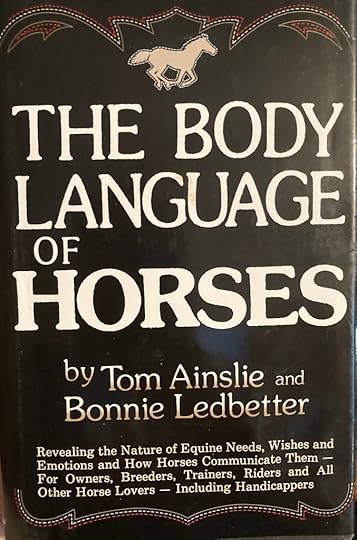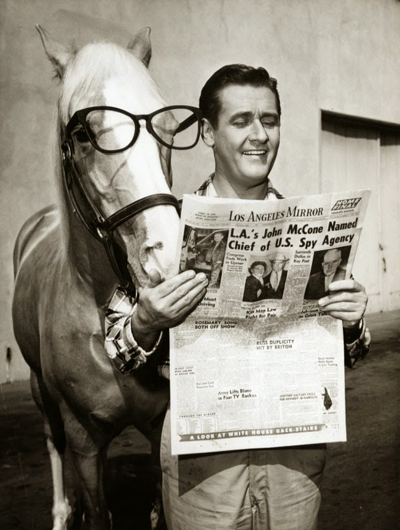Books That Changed My Life with Horses
I’ve been building a library of horse books since about the age of 11. I have no idea how many I have in my collection, now over 30 years on from when I first held the story of Man O’ War in my hands and read it by the light of my Raggedy-Ann lamp. A couple years after that, I got my first non-fiction horse book–a study of the body language of horses. At that point my horse library began in earnest.
For today’s post, I’d like to mention six books that have had a profound impact on how I view, understand, and interact with horses.
The Body Language of Horses Tom Ainslie and Bonnie Ledbetter (1980, William & Morrow publishers)
This was my first non-fiction horse book, a Christmas gift I received at the age of 13. I was still very new to horses at that point, having just started riding lessons and joined 4-H a couple of years before. This book offered my first glimpse of the world of horse body language. Up until that point I was unaware of body language as communication, beyond the pinning of ears or a kick or bite.
The most impactful stories which I still repeat to this day were the ones that demonstrated the affect of environment on behavior. This book is over 40 years old but still has much to offer. Of course we have learned more in the decades since, but it is well worth the read for the stories alone, if not for the valuable introduction to equine body language.
Getting In TTouchLinda Tellington-Jones, with Sybil Taylor (1995, Tralfagar Square Books)
I believe I read this book around 1999, and again in 2006. I was first introduced to Linda Tellington-Jones during one of my horse courses in college but it wasn’t until after graduation that I found this title at a book store. At the time I was looking to reconnect with that part of me that had read and loved The Body Language of Horses. During my time in college I’d become more of the mind that training was something you did to a horse–you taught him the right answer and he was expected to obey, no matter what. I struggled with the aggressiveness of that mindset, it never really sat right with me.
When I discovered this book, I was embarrassed to talk about it with my peers so I kept it to myself. But the content was so fascinating, I became particularly interested in the discussion about whorls and other facial features, and the behavior they seemed to be connected with. In 2006 I started work at a large Thoroughbred farm where I had access to hundreds of horses. I pulled out this book and reread it, comparing the information with the horses I worked with every day. Much of it was very accurate.
Many people scoff at the idea that the shape of the horses muzzle or the way the hair grows on the forehead could have anything at all to do with horse behavior. They are of course entitled to their opinion. But, I think skeptics tend to look at this backwards. No one is saying a particular whorl pattern CAUSES a specific personality trait, only that horses with specific whorls tend to have certain traits. Is it so hard to believe that whatever part of the DNA is responsible for certain personality traits also happens to be linked to the DNA that is responsible for a certain physical feature?
Tug of War: Classical Versus “Modern” DressageDr. Gerd Heuschmann (2007, J.A. Allen & Co.)
Written for the good of the horse. Dr. Hueschmann presents a sobering look at the direction “modern” dressage has taken, how far it has veered from it’s classical beginnings, and the damage it does to the horse. I can not look at today’s dressage horses the same since reading this book in 2007. The use of rolkur in training and the type of “dressage” it creates is unmistakable and devastating to see once you’ve allowed Dr. Heuschmann to open yours eyes.
I was taught classical techniques but had also ridden briefly under a trainer that did “modern” (or what I call “cram and jam”) dressage. My formerly light horse became heavy and resentful within a just a few weeks. I soon realized my arms hurt after a ride. If your arms/hands are sore, you’re doing it wrong. I stopped riding with this instructor and took over my own training until I could fine another like-minded instructor to help me. I also apologized profusely to my horse. It was almost 10 years after that experience that I read this book, which shed light on why my horse and I struggled so much with the other style and reaffirmed my belief in soft hands and classical methods.
Unfortunately, in the years since this book was first released, the “modern” training techniques are still in use and being rewarded in the show ring. The horses look fancy and flashy to the general public when compared to classically trained horses, drawing people to the sport, which I gather is why they allow it. But the horses are suffering for it. Please, even if you are not interested in dressage, read this book. For the good of your horse.
(It is not anti-bit, it is anti abusive use of the bit/hands)
What Horses SayAnna Clemence Mews & Julie Dicker (2004, Trafalger Square Books)
I believe I read this around 2009-10, I saw it in a book store and though “Ah, yes! This is just what I’m looking for!” What is funny though, as I walked around the store holding this book, I distinctly recalled picking it up a year or two before, reading the blurb, and putting it back thinking “This is too out-there for me!” I almost put it back a second time, but, as with the TTouch book, something in my life had flipped back to an earlier time, a memory (?) or maybe just an idea. But now, I was ready to listen.
This book was my first introduction to animal communication. The amazing stories were great to read, but also held a tiny bit of familiarity for me. This was something I understood on a deeper level. I wasn’t yet ready to dive in head first into the world of animal communication, but a door had been opened, and my curiosity piqued. I would revisit the subject again in the future.
At the time of my first reading, one thing really stood out for me. I realized that, despite my studies on equine communication through body language, I really had no clue how little we who focused solely on body language understood about horses. I also for the first time realized the depth of animal soul and what a disservice we humans did to them when we measured their ability to communicate and relate to the Creator through our own inadequate lens. We have so much to learn.
The Tao of EquusLinda Kohanov (2007, New World Library)
Although not the same style (training/communication/behavior focused) as the others, I added this book for two reasons. One, because this was my first introduction to the idea of incongruent human behavior (feeling one thing but presenting another) and how it affects the horse. Prior to that (2012), I had always been told and had never questioned the old adage that you must not let the horse know if you’re afraid or unsure or lacking confidence in yourself or the task ahead. The idea was that if you let the horse in your true feelings, he would a) also be afraid, and/or b) take advantage of you.
Kohanov turned this idea on its head for me. The horse already knows what you are thinking and feeling, it’s not something you can hide. The horse is fine-tuned in reading energy and intention, it’s part of their innate survival instincts. By attempting to hide these feelings, we are actually making the horse less comfortable.
The second impact this book had on my life is that it inspired me to finally write my own memoir called, Follow Me, Friend. You’ll hear more about it in the coming weeks as I prepare for it’s release!
Healing for HorsesMargrit Coates (2002, Sterling)
This is one of my most recent reads (2020). Farletta’s osteopath recommended it and loaned me her copy. Wasn’t I surprised when I found it on my own shelf! Apparently I had been nudged in the past to read it but it wasn’t quite the right time yet.
The author developed her own method of body work with energy and, while it shares similarity with Reiki, it isn’t a “system” or something that you have to learn but something that comes from a place of love (I will note here that Reiki is NOT a religion nor is it linked to a specific religion). What really resonated with me is the author’s description of how her work with energy actually brought her to faith in God, something she did not have before. I have had a similar experience. Where I’ve always believed in God, I feel closer to Him because of the love and light that is the energy we share with our horses and every living thing.
I’d love to hear what books have influenced you! Please share any titles in the comments below! And, if you’ve read any of the books on this list, I’d love to read your thoughts on them (please comment below).
Final thought: The dates/publishers listed in this post are from the actual editions I own. Some have more recent releases, others are out of print. All can be found online either used or new. If you have a local bookstore, please ask them if they can get a title for you. Supporting our local small businesses is good for our communities and our world.
Peace
Enter your email below to receive new posts directly into you inbox!
Email Address:
Subscribe!




